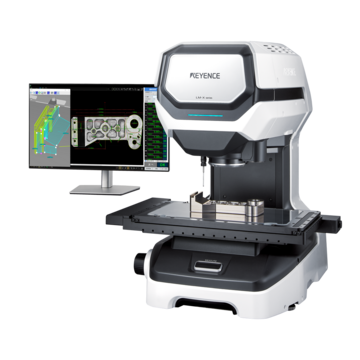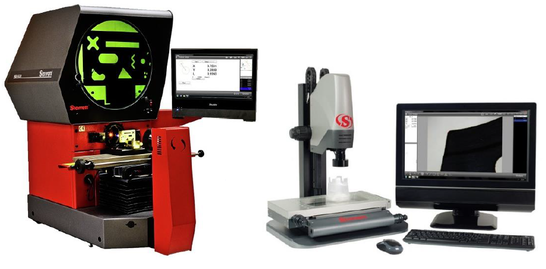The Function of Optical Measurement Solutions beforehand Metrology Methods
Optical measurement systems have actually changed width, bringing a degree of precision that was once unimaginable. As you discover additionally, you'll discover just how these systems are forming the future of measurement and top quality control.
The Evolution of Width: A Historic Perspective
As you discover the history of metrology, you'll discover that its evolution mirrors humankind's pursuit for precision and standardization. From ancient people using body components as systems of dimension to the advancement of standard weights and measures, each action shows our wish for precision. The Egyptians developed the pyramids making use of accurate dimensions, while the Romans advanced design with their innovative measuring tools.
Throughout the Renaissance, clinical advancements changed the focus toward more empirical techniques, leading the way for modern-day metrology. The introduction of the metric system in the late 18th century marked a substantial milestone, establishing universal standards. Throughout the 20th century, technological improvements further transformed metrology, making it possible for extremely accurate measurements in different areas.
Today, width remains to progress, incorporating digital innovation and automation. This background highlights not simply the importance of dimension yet additionally our relentless pursuit of improving accuracy and consistency in our increasingly complex world.
Principles of Optical Measurement Solutions
Recognizing the concepts behind optical dimension systems is essential for accurate lead to metrology. You'll desire to think about basic optical concepts, dimension accuracy elements, and efficient system calibration methods. Each of these aspects plays an essential duty in ensuring your measurements are reliable and precise.
Fundamental Optical Concepts
While discovering optical measurement systems, you'll come across fundamental optical principles that create the backbone of precise information acquisition. Light acts in predictable methods, and recognizing these behaviors-- like diffraction, refraction, and representation-- is vital for reliable measurements. By mastering these concepts, you'll be outfitted to leverage optical innovations successfully, leading the way for developments in assessment and ensuring your dimensions are both reliable and repeatable.
Dimension Precision Aspects
To attain high measurement precision in optical systems, a number of factors come right into play, influencing the integrity of your results. High-grade lenses and detectors minimize aberrations and noise, ensuring your dimensions are accurate. By addressing these elements, you can boost the general efficiency of your optical measurement systems, leading to even more reliable and exact results in your width applications.
System Calibration Techniques
Accomplishing high dimension precision is just part of the equation; proper system calibration methods are similarly important in optical measurement systems. To ensure your system provides reputable results, you must regularly adjust it making use of standard referral products. Begin by changing the optical components, like lenses and mirrors, to minimize systematic mistakes. Next off, utilize recognized measurements to validate the system's result and make needed modifications. It's likewise essential to account for ecological aspects-- temperature and humidity can influence measurements. Implement a regular calibration routine to maintain uniformity gradually. Finally, record all calibration procedures and results; this will certainly help you track efficiency and attend to any drift in accuracy. With these methods, you'll enhance the integrity of your optical measurement system.
Key Technologies Behind Optical Measurement
Optical dimension systems rely upon a number of vital innovations that boost precision and effectiveness in width. One important modern technology is interferometry, which uses the disturbance of light waves to measure little variations and surface irregularities with severe accuracy. You'll additionally find laser scanning systems, which capture in-depth 3D information of things rapidly, making them very useful for dimensional analysis.
Furthermore, CCD and CMOS sensing units play a substantial duty in converting light into electrical signals, enabling high-resolution imaging and exact dimensions. Advanced formulas for photo processing additionally enhance measurement accuracy by evaluating data in real time, straining noise and enhancing functions.
Ultimately, fiber optics give adaptability and the capability to determine in difficult environments while maintaining signal stability. By leveraging these innovations, you can accomplish exceptional results in your assessment tasks, making sure that your measurements are both precise and dependable.
Applications of Optical Measurement in Sector
As sectors progressively demand precision and performance, the applications of optical dimension systems have become vital throughout different industries. In production, these systems aid you keep an eye on measurements and tolerances in real-time, making certain top quality control without lengthy manual checks. In the automotive sector, optical measurements assist in straightening elements with accuracy, enhancing safety and performance.
In electronic devices, you're utilizing optical approaches to evaluate min features on circuit card, identifying flaws that could lead to failings. The aerospace industry take advantage of non-destructive screening strategies, allowing you to evaluate materials and parts without compromising their integrity.
Optical measurement likewise plays a vital role in fabrics, making certain fabric measurements satisfy precise requirements. optical measurement. With their capability to provide high-resolution information rapidly, these systems empower you to make informed decisions, simplify procedures, and ultimately drive development across your industry
Enhancing Accuracy and Efficiency in Dimensions
When you consider enhancing precision in measurements, accuracy in your measurement methods is important. By simplifying these procedures, you can accomplish quicker results without compromising top quality. Let's check out exactly how taking on sophisticated optical measurement systems can boost both accuracy and efficiency in your job.
Precision in Measurement Techniques
Accuracy in dimension strategies is vital for attaining trustworthy cause assessment, specifically because tiny discrepancies can cause considerable errors. By using sophisticated optical measurement systems, you can boost the accuracy of your measurements. These systems offer high-resolution data that aid you spot also the smallest variations in dimensions. When you embrace these technologies, you lessen uncertainties and boost repeatability in your processes. Furthermore, precise measurements enable you to keep quality assurance, guaranteeing that products meet strict specs. This not only improves your integrity however likewise enhances consumer contentment. Buying accuracy dimension tools eventually causes boosted effectiveness, reduced waste, and enhanced manufacturing cycles. Accepting these techniques will transform your strategy to width, yielding amazing results.
Streamlining Dimension Processes
To boost precision and effectiveness in dimensions, improving your measurement procedures is crucial. Start by adopting optical dimension systems that provide real-time data, lowering the time invested on manual recording. These systems frequently integrate seamlessly with existing software program, enabling you to automate information collection and evaluation.
Next, standardize your measurement methods. By carrying out consistent procedures, you reduce irregularity and enhance repeatability. Do not neglect to regularly calibrate your equipment to assure its accuracy.

The Effect of Optical Measurement on R & D
As scientists endeavor to press the boundaries of development, optical measurement systems have become indispensable tools in the development process. These systems give you with precise, real-time information that boosts your capacity to analyze complex products and structures. In numerous fields, from biotechnology to aerospace, you rely on optical dimensions to improve and maximize styles product he has a good point performance.

With high-resolution imaging and non-contact approaches, you can lessen example disturbance, permitting more exact results. This ability to record minute information increases your R&D cycle, allowing you iterate designs quickly and successfully. Additionally, optical measurement promotes collaboration across disciplines, as the data generated is commonly conveniently interpretable and shareable.
Eventually, integrating optical measurement systems into your research not only enhances efficiency but additionally grows your understanding of the phenomena you research. By leveraging these advanced methods, you're much better equipped to innovate and remain ahead in an affordable landscape.
Future Trends in Optical Dimension Solutions
With the quick innovation of technology, you're most likely to see substantial shifts in optical dimension systems that will certainly redefine their application throughout different markets. You'll notice an approach boosted automation and combination of expert system, enabling for real-time information evaluation and boosted accuracy. Miniaturization is an additional trend; portable tools will certainly allow measurements in tighter spaces, making them ideal for fields like aerospace and biomedical applications.
Additionally, the advent of sophisticated products, such as photonic crystals, will enhance sensitivity and resolution. Expect to see systems that can operate in challenging atmospheres, giving trusted measurements in extreme problems. Cloud-based analytics will certainly additionally play a vital duty, supplying you accessibility to big datasets for much better decision-making. As these innovations converge, you'll find that optical measurement systems not just boost precision but likewise improve operations, ultimately driving technology and efficiency in your tasks.
Often Asked Questions
How Do Optical Dimension Systems Compare to Traditional Measurement Techniques?
Optical measurement systems offer greater accuracy and faster outcomes contrasted to traditional strategies. You'll find they capture more information factors precisely, minimizing human error and increasing dependability, making them a recommended option in various applications.
What Industries Advantage The Majority Of From Optical Dimension Equipments?
You'll locate markets such as aerospace, auto, and electronics benefit most from optical dimension systems. These industries rely upon accurate measurements to ensure quality and efficiency, enhancing efficiency and minimizing costs through innovative innovation.

Are Optical Measurement Equipments Expensive to Execute?
Optical dimension systems can be expensive to apply, but their precision and performance frequently justify the expense. Investing in such innovation can result in substantial long-term cost savings and improvements in top quality throughout different applications.
What Skills Are Needed to Operate Optical Dimension Solutions?
To operate optical dimension systems, you'll require solid logical abilities, attention to detail, and efficiency in software application devices. Experience with optics and an understanding of measurement principles will certainly likewise improve your effectiveness and efficiency.
Just How Do Environmental Aspects Affect Optical Measurements?
Ecological elements like air, humidity, and temperature level quality can distort optical dimensions. You'll observe variations in accuracy due to light disturbance or refraction. optical measurement system. Maintaining secure conditions is crucial for accurate and reliable optical measurement outcomes
Final thought
In summary, optical measurement systems are reinventing metrology by giving unequaled precision and efficiency. By utilizing advanced principles and modern technologies, these systems improve precision while decreasing disruptions in various sectors. As you explore future trends, you'll see exactly how the combination of AI and automation will certainly proceed to raise measurement techniques, driving advancement and enhancing quality assurance. Welcoming these innovations will certainly be vital for staying affordable and attaining excellence in your field.
Accomplishing high measurement accuracy is only component of the equation; proper system calibration techniques are equally essential in optical dimension systems.When you assume regarding improving accuracy in dimensions, precision in your measurement techniques is crucial. By making use of sophisticated optical dimension systems, you can improve the precision web link of your dimensions.To enhance accuracy and effectiveness in measurements, improving your measurement processes is crucial. Just How Do Optical Dimension Solutions Contrast to click reference Standard Dimension Techniques?